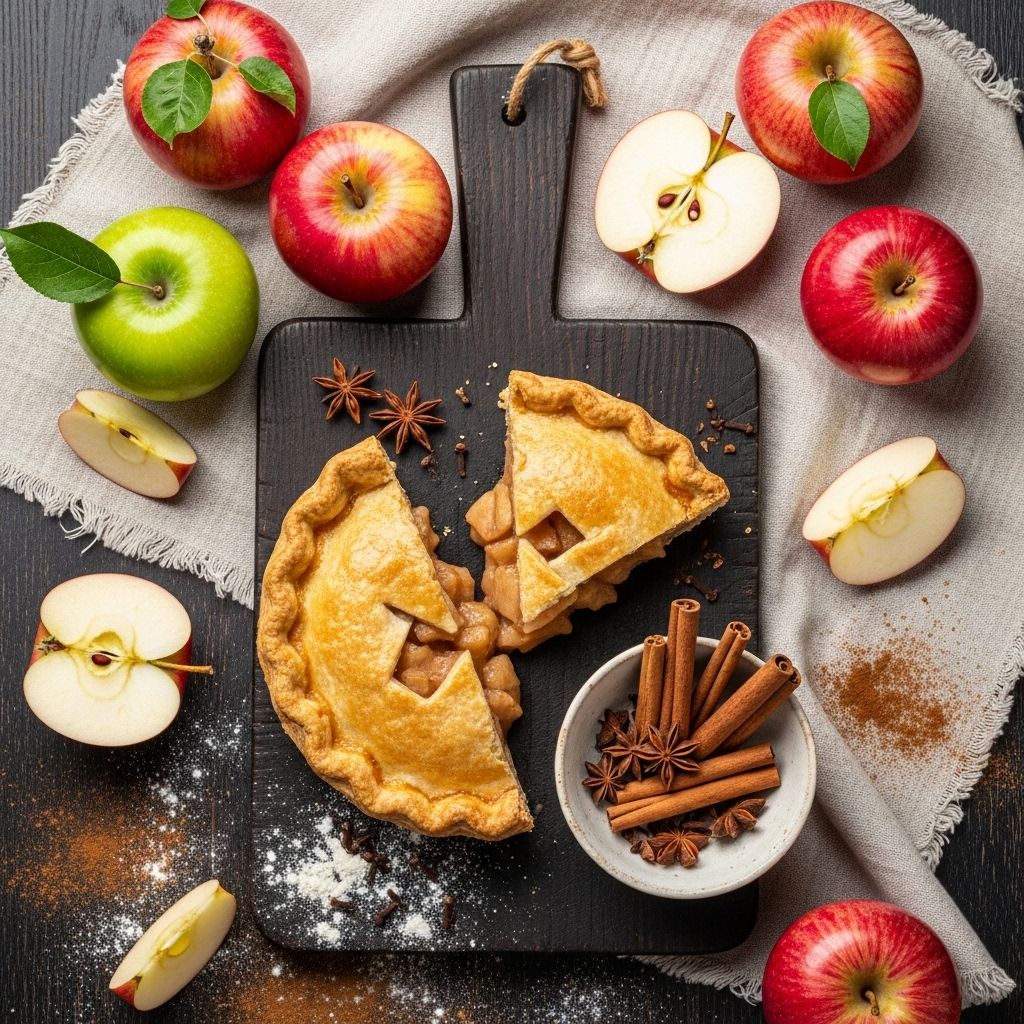The Ultimate Guide to Choosing Apples and Making the Perfect Apple Pie
Unlock the secrets to a golden crust and balanced flavors in every slice.

There’s nothing more iconic than a delicious, homemade apple pie straight from the oven. But which apples should you choose? How do you prevent a soggy crust or keep the filling from turning to mush? This comprehensive guide covers everything you need to know, from picking the right apple varieties, mastering the filling, to baking a pie with beautiful, golden crust. Bring classic flavor to your kitchen and bake your best apple pie ever!
Why the Right Apple Makes the Pie
Choosing the right apple is crucial for a perfect pie because apples vary widely in flavor, moisture content, firmness, and how they behave when baked. The best apple pies strike a balance between sweet and tart flavor, maintain a satisfying texture, and don’t flood the crust with excess liquid.
- Flavor: Tart apples balance sweetness and provide complexity.
- Texture: The ideal apples hold their shape, giving you tender but distinct slices after baking.
- Moisture: Apples that release too much juice turn the filling soupy and make for a soggy pie bottom.
Understanding Apple Varieties: Which Are Best for Pie?
Let’s break down popular apple varieties and their suitability for pies. Combining several varieties often yields the best results, adding depth and dimension in flavor and texture.
| Apple Variety | Texture After Baking | Taste Profile | Best Use in Pie |
|---|---|---|---|
| Granny Smith | Very firm | Tart, bright | Excellent base apple; provides structure & tartness |
| Honeycrisp | Crisp, holds shape | Sweet-tart, aromatic | Add for juiciness & layered flavor |
| Golden Delicious | Softens gently | Sweet, mellow | Balances tart apples with softness |
| McIntosh | Breaks down, very soft | Sweet, fragrant | Add sparingly for juiciness |
| Braeburn | Firm, juicy | Spicy-sweet | Holds shape, adds complexity |
| Cortland | Medium, doesn’t brown | Mild, sweet | Makes pie less tart, good for kids |
| Fuji | Somewhat firm | Very sweet | Use with tarter apples |
| Jonagold | Medium firm | Honeyed, tangy | Great for balanced sweetness |
| Rome Beauty | Keeps shape | Mild, light tartness | Good supporting apple |
Mix and Match: Building the Ideal Apple Mix
The very best pies blend tart and sweet apples, firm and soft varieties. This gives the pie complexity and the right filling texture—tender, not mushy or watery.
- Start with a base: Use Granny Smith for tartness and structure.
- Add depth: Honeycrisp or Braeburn bring sweetness and juice without collapsing.
- Round out flavor: Drop in Golden Delicious, Jonagold, or a touch of McIntosh for aroma and juiciness.
Try a 50/50 blend of tart and sweet apples, or experiment with three or four types to find your ideal flavor.
Apple Pie Pitfalls: Common Mistakes and How to Avoid Them
Even with great apples, several factors can derail your pie. Here’s what to watch out for:
- Mushy filling: Using only soft apples (like McIntosh) leads to applesauce pies.
- Watery pies: Apples high in water, or not enough thickener, results in soupy pies.
- Bland taste: Sticking to just one apple may lack depth. Blend varieties for contrast.
- Tough crust: Overworking dough or soggy bottom crust can ruin texture.
The Science Behind Perfect Apple Pie Filling
To achieve a thick, flavorful filling packed with pronounced apple flavor (not mush), it’s important to:
- Cut apples uniformly: Slicing apples to even thickness ensures consistent texture throughout the pie.
- Add sugar and salt early: Tossing apples with sugar and salt draws juices out and intensifies the apple flavor.
- Use the right thickener: All-purpose flour, cornstarch, tapioca, and potato starch are all options. Cornstarch is often preferred for its clarity and smoothness, but tapioca works very well for a glossy, firm filling.
Thickeners for Apple Pie
| Thickener | Texture | Flavor Impact |
|---|---|---|
| Cornstarch | Smooth, clear, firm | Neutral |
| Flour | Opaque, slightly pasty | Mild wheat flavor |
| Instant tapioca | Glossy, sliceable | Neutral |
| Potato starch | Stable, slightly springy | Subtle potato notes |
Pre-Cooking: Should You Pre-Bake Your Filling?
Some bakers swear by pre-cooking apples before they go into the pie. This method removes excess water and ensures the apples shrink before you seal them under crust—eliminating air pockets and shrinking fillings. However, too much cooking leads to mushy apples. Consider:
- Fast sauté: Briefly sauté apple slices in a pan until they just start to soften (about 5 minutes).
- Strain and reduce juices: Macerate with sugar, strain off juices, and simmer them into a syrup, which is mixed back into the apples for intense flavor and less wateriness.
Assembling the Pie: Filling and Crust Tips
A great apple pie is much more than just the apples. How you arrange, season, and bake the filling affects every bite.
Flavoring the Filling
Classic apple pie spices include cinnamon, nutmeg, and allspice, but their amounts are a matter of taste. Start light—you can always add more.
- Lemon juice: Brightens the filling and offsets sweetness.
- Vanilla extract: Optional, but brings floral aroma to the pie.
- Butter: A few dots of butter on the filling before baking add rich mouthfeel.
Building the Pie
- Roll out your bottom crust and let it drape over the pie plate.
- Mound the apples high—they shrink as they bake.
- Top with second crust, lattice, or crumble.
- Crimp edges firmly to seal and cut vents to let steam escape.
- Brush with egg wash or milk for shine, sprinkle with coarse sugar for crunch.
Baking Secrets for Crispy, Golden Crust
The right oven temperature and baking time are crucial. Most apple pies bake at 400°F (204°C) for the first 20–30 minutes, then finish at 375°F (190°C). This ensures a golden-brown crust and fully cooked apples without burning.
- Always bake on a lower oven rack: This helps the bottom crust brown.
- Use a pre-heated baking sheet: Place your pie pan directly on a hot sheet to jump-start browning and prevent soggy bottoms.
- Let it cool: Allow the pie to cool before slicing. This lets the juices gel and prevents runny filling.
Master Recipe: Classic American Apple Pie
Ingredients:
- 2 1/2 pounds total, mixed apples (Granny Smith, Honeycrisp, Braeburn, etc.), peeled and sliced 1/2 inch thick
- 3/4 cup granulated sugar
- 1/4 teaspoon kosher salt
- 1 tablespoon lemon juice
- 1/2 teaspoon ground cinnamon (or to taste)
- 1/4 teaspoon nutmeg (optional)
- 1–2 tablespoons cornstarch (or other thickener)
- 2 teaspoons vanilla extract (optional)
- 2 tablespoons unsalted butter, cut into small pieces
- 1 double (top & bottom) pie crust (homemade or store-bought)
- 1 egg, beaten with 1 tablespoon water, for egg wash
- Coarse sugar, for sprinkling
Instructions:
- Adjust oven rack to lower-middle position and preheat oven to 400°F (204°C). Place a rimmed baking sheet on the rack.
- In a large bowl, toss apples with sugar, salt, lemon juice, spices, and cornstarch. Let sit 20 minutes to draw juices.
- Roll out bottom crust and fit it into a 9-inch pie plate. Let excess dough hang over the edge.
- Pour apples along with any juices into the crust. Dot with butter.
- Cover with top crust (full or lattice). Seal and crimp the edges. Cut 4–6 slits or vents.
- Brush with egg wash and sprinkle with coarse sugar.
- Bake pie on preheated baking sheet for 20–30 minutes. Lower heat to 375°F (190°C) and bake 30–40 minutes more, until filling is bubbling and crust is deeply golden.
- Cool on a wire rack at least 2 hours before slicing.
Troubleshooting: How to Fix a Soggy Pie or Runny Filling
If your pie bottom turns mushy or the filling spills out, here’s what to try next time:
- Increase your thickener slightly or pre-cook the apples.
- Allow the pie to cool completely to let juices set.
- Use a metal pie pan for faster heat transfer.
- Rebake under foil if crust and filling are underdone.
Frequently Asked Questions (FAQs)
Q: Can I freeze apple pie or the filling?
A: Yes, both assembled but unbaked pies and cooked filling (without crust) freeze beautifully. Wrap tightly and bake from frozen, adding about 15 minutes to bake time.
Q: How do I stop my crust from getting soggy?
A: Bake on a hot surface, use coated pie pans, and let the filling cool so it doesn’t steam the crust from the inside. Avoid too much liquid in the filling.
Q: What apples can I substitute if my favorites aren’t available?
A: Mix any tart apple (like Pink Lady or Empire) with sweeter, firmer ones (like Fuji or Gala) for balanced flavor and great texture.
Q: Is it better to peel apples for pie?
A: Peeling is recommended for the best texture, but leaving peels on adds color and rustic charm—just be sure to use thin-skinned apples.
Q: How much sugar should I use? My apples are very sweet.
A: You can reduce the sugar by up to a third for very sweet apples, but don’t skip it entirely as it helps draw juices and set the filling.
Wrapping Up: Your Perfect Pie Awaits
Great apple pie begins with thoughtful apple selection and mindful technique. Mix apples for complexity, use the right thickener, and bake on a hot surface for a crisp crust. With the tips in this guide, every slice you serve will offer luscious, distinct apples encased in a golden, flaky crust—a celebration of the art and science of pie-making. Happy baking!
References
Read full bio of Srija Burman












